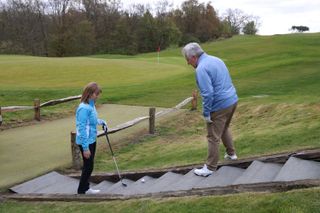Five Of The Most Common Immovable Obstructions In Golf
What is an immovable obstruction in golf? What immovable obstructions are you most likely to encounter and what’s the procedure if you do?


There are Rules in golf that appear unfair (even if there is good reason for them.) But there are also rules designed to help you where possible. Sometimes, just occasionally, there’s a rule that (if you know about it) might just help you avoid an awkward situation. Immovable Obstructions are a case in point. If you encounter one on the course, you might initially think you’re in a sticky predicament, but you may be entitled, under the rules, to improve your situation.
What Is An Immovable Obstruction?

This is one
An immovable obstruction is defined in the Rules as: Any obstruction that cannot be moved without unreasonable effort or without damaging the obstruction or the course, and that otherwise doesn’t meet the definition of a movable obstruction.
A movable obstruction would be something like a plastic bottle or a bunker rake. They can be removed without penalty under Rule 15.2.
Do I get free relief from an immovable obstruction?

You'll get relief from here
Quite possibly, under Rule 16.1. If the immovable obstruction interferes with either your lie, your stance or the area of your intended swing, you are entitled to free relief.
One caveat – Rule 16.1a(3) – You are not entitled to free relief if it would be “clearly unreasonable” for you to make a stroke at the ball even were there not an immovable obstruction involved – i.e. your ball is in the middle of a bush. Also, if you are making a “clearly unreasonable” stance to claim interference i.e pointing in the wrong direction, or suggesting you would be using a “clearly unreasonable” club to claim interference. i.e pulling out a driver when you’re 60 yards from the green.
Unless your ball sits on the putting green, you are not entitled to relief from the immovable obstruction if it is simply in your line of play. You are not entitled to relief if the immovable obstruction simply distracts you.
And How Do I take relief?
If your ball is in the General Area, you find a reference point (this is your nearest point of complete relief, no nearer to the hole.) You then drop (from knee height) within one club length of that reference point (no nearer the hole.) You must take complete relief from the immovable obstruction – It must no longer interfere with your lie, stance or area of intended stroke.
Get the Golf Monthly Newsletter
Subscribe to the Golf Monthly newsletter to stay up to date with all the latest tour news, equipment news, reviews, head-to-heads and buyer’s guides from our team of experienced experts.
On the putting green you would place the ball at the nearest point of complete relief.
Five Of the most common Immovable Obstructions

Sprinkler head
1 - Sprinkler Head – On most courses today, you’ll find a number of these on every hole. They may be small but it’s amazing how often they get in the way.
2 - Cart Path – Again, many modern courses have cart paths and they snake their way up every hole.
3 - Internal Fence – Unless it’s deemed an Integral Object by the committee, from which free relief is not allowed, an internal fence would be classed as an immovable obstruction. Boundary fences are not immovable obstructions and there is no relief from them.
4 - Rubbish Bin – You’ll find them around most teeing areas.
5 - Water Fountain – You’ll occasionally find them around teeing areas.
There are plenty of other possible examples of immovable obstructions – Basically anything not deemed an “integral object” by the committee. So: a rain shelter, a ball washer, a bench, a pathway, an ornamental flowerpot, a statue of Old Tom Morris… And so on…

Fergus is Golf Monthly's resident expert on the history of the game and has written extensively on that subject. He has also worked with Golf Monthly to produce a podcast series. Called 18 Majors: The Golf History Show it offers new and in-depth perspectives on some of the most important moments in golf's long history. You can find all the details about it here.
He is a golf obsessive and 1-handicapper. Growing up in the North East of Scotland, golf runs through his veins and his passion for the sport was bolstered during his time at St Andrews university studying history. He went on to earn a post graduate diploma from the London School of Journalism. Fergus has worked for Golf Monthly since 2004 and has written two books on the game; "Great Golf Debates" together with Jezz Ellwood of Golf Monthly and the history section of "The Ultimate Golf Book" together with Neil Tappin , also of Golf Monthly.
Fergus once shanked a ball from just over Granny Clark's Wynd on the 18th of the Old Course that struck the St Andrews Golf Club and rebounded into the Valley of Sin, from where he saved par. Who says there's no golfing god?
-
 The 'Diabolical' Overhanging Tree Everyone Is Talking About At The Players Championship
The 'Diabolical' Overhanging Tree Everyone Is Talking About At The Players ChampionshipAfter the old one was lost to disease in 2014, a new overhanging oak tree arrived just in front of the sixth tee box at TPC Sawgrass' Stadium Course in 2025
By Jonny Leighfield Published
-
 Brandel Chamblee Claims There Would Be 'Uproar On The PGA Tour' If LIV Golfers Were Allowed To Play Signature Events
Brandel Chamblee Claims There Would Be 'Uproar On The PGA Tour' If LIV Golfers Were Allowed To Play Signature EventsThe Golf Channel analyst claimed 'it would be wrong' if players from the LIV Golf League were allowed to play Signature Events on the PGA Tour
By Matt Cradock Published